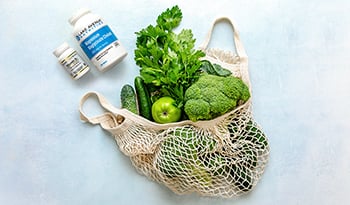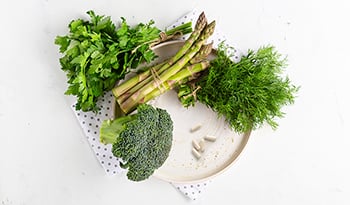Signs of Low Potassium—And How to Improve Your Levels Naturally
DISCLAIMER:This blog does not intend to provide diagnosis...
- In this article:
- What Is Potassium?
- Health Benefits of Potassium
- Signs and Symptoms That You Might Have Low Potassium
- How to Find Out if You Have Low Potassium
- Top Ways to Improve Potassium Naturally
- Potassium-Rich Foods
- Supplements to Replete Potassium Levels
- The Bottom Line

Have you heard of potassium? Most of us have heard about potassium when talking about bananas or electrolytes at sports games, but potassium is so much more! This article will help you understand potassium’s important role in your health, the signs and symptoms of low potassium, and how you can work with your practitioner to improve your potassium levels naturally.
What Is Potassium?
Potassium is an essential mineral that is vital in how our bodies function. Did you know that it’s also an electrolyte? That means it carries an electric charge and activates nerve and cell functions in every human cell. It’s also key to regulating how the body balances fluids, maintains blood pressure, and supports healthy muscles and nerves.
Our need for potassium varies with age, but a typical healthy adult needs around 2,500 to 3,000 milligrams of potassium per day. When recommending, your practitioner will also consider your sex, activity level, and current nutritional profile.
Health Benefits of Potassium
As much as we need potassium for daily vital functions, the human body doesn’t produce it. So, we must consume potassium daily to maintain adequate levels in our tissues and blood. Many of us have learned that we can get potassium from bananas, but many other foods and supplements nourish the body’s potassium level. First, here are a few ways potassium supports our bodies so we can thrive.
Overall Health
Overall—we all need adequate potassium! Consuming the right amount of potassium is key to overall health. Low potassium can contribute to issues like muscle weakness, irregular heartbeats, constipation, and the other signs and symptoms below.
Muscles and Nerves
Potassium helps nerve impulses. It also helps muscles, including the heart, contract. If potassium is low, then all our muscles can be compromised.
Blood Pressure
Adequate levels of potassium are needed to maintain blood pressure. Potassium can counteract the sodium in your body to maintain a good balance of fluids, which is critical to blood pressure.
Signs and Symptoms That You Might Have Low Potassium
Low potassium, or hypokalemia, indicates below-normal potassium levels in the blood. It can be dangerous if not caught early, and has been implicated in cardiac disease, renal failure, malnutrition, and even shock.5 You and your practitioner can keep an eye on potassium levels through routine blood work. You can also track your intake using an app like Cronometer or MyFitnessPal.
Contact your practitioner if you have any of these signs or symptoms of low potassium:
- Muscle weakness, cramps, spasms, numbness, or tingling, particularly in the arms, hands, legs, or feet
- Fatigue, or feeling tired or weak, even after getting adequate sleep
- Heart palpitations or irregular heartbeats
- New or unusually high blood sugar levels
- Dehydration, which could be a result of increased urination
- Constipation or other persistent digestive concerns
- New anxiety, depression, or other mood changes
Sometimes, medical conditions or medicines can lower your potassium levels. Issues like kidney disease, Crohn’s disease, ulcerative colitis, vomiting, and diarrhea, and medications such as diuretics or laxative abuse can be the culprits.
How to Find Out if You Have Low Potassium
Sometimes, low potassium is discovered through a routine basic metabolic panel (BMP). Or, your practitioner may order a BMP and/or a urinalysis if they suspect a potassium issue. These tests measure the amount of potassium in your blood and what you’re excreting in your urine. Your practitioner may dig a little deeper with a comprehensive metabolic panel (CMP) to check your kidney function and electrolytes. This is important detective work to get to the root cause of your signs and symptoms.
Top Ways to Improve Potassium Naturally
First and foremost—Consult your healthcare practitioner to determine your current potassium level and, if it’s low, how much potassium you need to incorporate through diet and supplementation.
Great news—There are many tasty foods to raise your potassium levels and get you thriving again! Eating from the rainbow of fruits and vegetables and varying protein sources is always good. The National Institutes of Health lists high-potassium foods that meet every dietary preference while improving potassium levels.
Potassium-Rich Foods
Food | Milligrams (mg) per serving | Percent DV |
Apricots, dried, ½ cup | 755 | 16 |
Lentils, cooked, 1 cup | 731 | 16 |
Squash, acorn, mashed, 1 cup | 644 | 14 |
Prunes, dried, ½ cup | 635 | 14 |
Raisins, ½ cup | 618 | 13 |
Potato, baked, flesh only, 1 medium | 610 | 13 |
Kidney beans, canned, 1 cup | 607 | 13 |
Orange juice, 1 cup | 496 | 11 |
Soybeans, mature seeds, boiled, ½ cup | 443 | 9 |
Banana, 1 medium | 422 | 9 |
Beverages
Coconut water is a good source of natural electrolytes, including potassium. The healthiest options are coconut waters free of artificial flavors, colors, and additives. Conversely, avoid excessive caffeine and alcoholic drinks, which can deplete potassium. Your practitioner can help determine what’s right for you.
Supplements to Replete Potassium Levels
You might look at the potassium-rich food list and think, “maybe I’ll just take a supplement!” And that is an option. However, you must be mindful of not taking too much potassium—you don’t want to develop hyperkalemia, or high potassium, either.
The best place to start is with your practitioner, who can identify, through testing, how much supplemental potassium you need. In general, you won’t exceed 99 milligrams per day. If you’re on a diuretic, heart, or acne medication, your practitioner will advise against supplemental potassium and point you toward high-potassium food sources.
The most common supplements to support optimal levels are potassium chloride, potassium citrate, potassium aspartate, potassium bicarbonate, and potassium gluconate. Your practitioner will review your dietary intake and recommend the form and dosage that’s right for you.
The Bottom Line
You don’t have to suffer from the nagging symptoms that come from low potassium, from muscle imbalances to fatigue, heart issues to high blood sugar, and more listed above. If you’re experiencing signs and symptoms that point to low potassium, visit your practitioner for testing. If you do have hypokalemia, you can easily and naturally boost your levels with diet and supplements under your practitioner’s direction. It’s your birthright to feel healthy and happy. These interventions will rule out other medical conditions, help you feel better, and get you thriving again!
References:
- Potassium. (2019, June 3). The Nutrition Source. https://www.hsph.harvard.edu/nutritionsource/potassium/
- Office of Dietary Supplements - Potassium. (2021). Nih.gov. https://ods.od.nih.gov/factsheets/Potassium-Consumer/
- Low Potassium Level Causes (Hypokalemia). (2022). Cleveland Clinic. https://my.clevelandclinic.org/health/diseases/17740-low-potassium-levels-in-your-blood-hypokalemia
- Potassium Information | Mount Sinai - New York. (2014). Mount Sinai Health System. https://www.mountsinai.org/health-library/supplement/potassium
- Castro, D., & Sharma, S. (2022, September 12). Hypokalemia. Nih.gov; StatPearls Publishing. https://www.ncbi.nlm.nih.gov/books/NBK482465/
- Office of Dietary Supplements - Potassium. (2019). Nih.gov. https://ods.od.nih.gov/factsheets/Potassium-HealthProfessional/

 By Dr. Kate Henry, N.D.
By Dr. Kate Henry, N.D.


